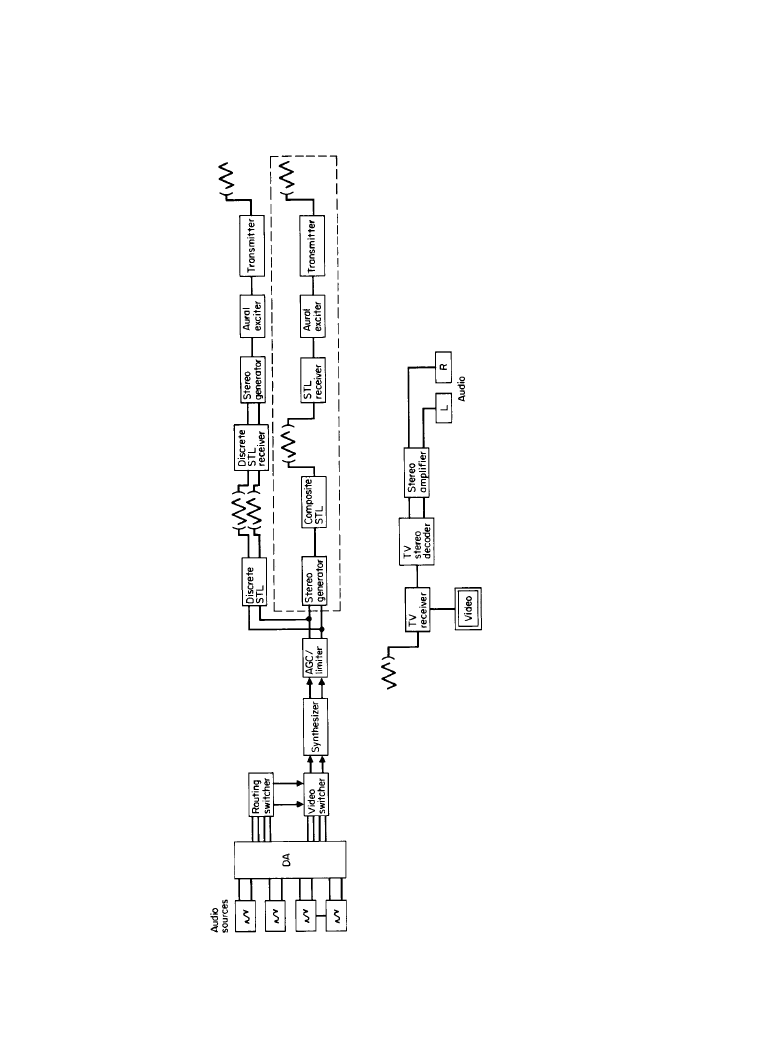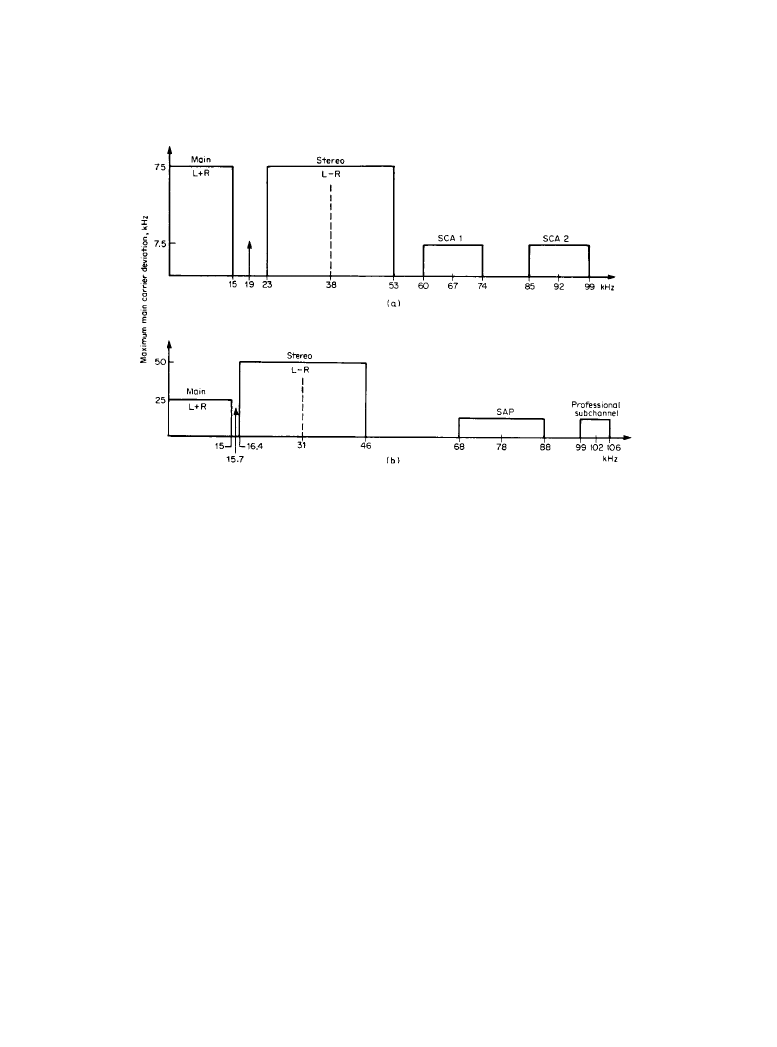ВУЗ: Казахская Национальная Академия Искусств им. Т. Жургенова
Категория: Книга
Дисциплина: Не указана
Добавлен: 03.02.2019
Просмотров: 21602
Скачиваний: 19

AM and FM Receivers 12-73
with an I detector. The two signals are compared, and the resultant error is used to gain-modulate
the input of the I and Q demodulators.
When the transmitted signal is L + R (monaural, no stereo), it is pure AM (only I sidebands).
In this case the envelope detector and the I demodulator see the same thing. There is no error sig-
nal, the inverse modulator does nothing, and the signal passes without change. However, when a
left- or right-only signal is transmitted, both AM and PM are present, and the input signal is
shifted in phase to the I demodulator, which loses some of its I amplitude. The envelope detector
sees no difference in the AM because of the phase modulation. When the envelope detector and
the I demodulator are compared, there is an error signal. The error signal increases the input level
to the detector. This makes the input signal to the I and Q demodulators look like a pure quadra-
ture signal, and the audio output yields the L – R information. The demodulator output is com-
bined with the envelope-detector output in a matrix to reconstruct the left and right audio
channels.
12.3.5 References
1.
Rohde, Ulrich L, and Jerry C. Whitaker: Communications Receivers, 3rd ed., McGraw-
Hill, New York, N.Y., 2000.
2.
Rohde, Ulrich L.: Digital PLL Frequency Synthesizers, Prentice-Hall, Englewood Cliffs,
N.J., 1983.
3.
Amos, S. W.: “FM Detectors,” Wireless World, vol. 87, no. 1540, pg. 77, January 1981.
12.3.6 Bibliography
Benson, K. Blair, and Jerry C. Whitaker: Television and Audio Handbook for Engineers and
Technicians, McGraw-Hill, New York, N.Y., 1990.
Whitaker, Jerry C. (ed.): NAB Engineering Handbook, 9th ed., National Association of Broad-
casters, Washington, D.C., 1999.
Downloaded from Digital Engineering Library @ McGraw-Hill (www.digitalengineeringlibrary.com)
Copyright © 2004 The McGraw-Hill Companies. All rights reserved.
Any use is subject to the Terms of Use as given at the website.
AM and FM Receivers

Downloaded from Digital Engineering Library @ McGraw-Hill (www.digitalengineeringlibrary.com)
Copyright © 2004 The McGraw-Hill Companies. All rights reserved.
Any use is subject to the Terms of Use as given at the website.
AM and FM Receivers

12-75
Chapter
12.4
Stereo Television
K. Blair Benson
12.4.1 Introduction
The adoption of the Zenith-dbx system for multichannel television sound (MTS) in December
1983 paved the way for the commercial transmission of stereo audio and second-language pro-
gramming in the U.S. The MTS nomenclature is a mixture of borrowed FM and some new MTS-
specific terminology. This chapter discusses the broadcast-equipment specifications that have
the most significant impact on MTS-system performance and gives brief explanations of the
MTS terminology.
A typical origination-to-end-user block diagram is given in Figure 12.4.1. Alternate paths are
shown in the transmitter section, one for discrete encoding and the other for composite encoding
in the studio-transmitter link (STL). The transmission components may be grouped into the fol-
lowing categories:
•
Audio chain
•
Stereo generators
•
Composite STL
•
Aural exciter
12.4.2 Audio Chain
The audio chain includes distribution amplifiers, mixers, switchers, processors, studio-transmit-
ter link (STL), wiring, and connections between the audio source and the TV MTS generator.
The most important performance specifications for equipment in the audio chain are frequency
response, signal-to-noise ratio (S/R), distortion, separation, headroom, and channel-to-channel
tracking.
12.4.2a Stereo Generator
The TV stereo system is a modification of the standard FM stereo system [1–3]. The main differ-
ences are:
Downloaded from Digital Engineering Library @ McGraw-Hill (www.digitalengineeringlibrary.com)
Copyright © 2004 The McGraw-Hill Companies. All rights reserved.
Any use is subject to the Terms of Use as given at the website.
Source: Standard Handbook of Audio and Radio Engineering

12-76 Radio Receivers
Figur
e 12
.4.1
T
y
p
ic
a
l t
e
le
vi
si
on
MT
S
sy
s
te
m
b
lo
c
k
di
ag
ra
m.
Downloaded from Digital Engineering Library @ McGraw-Hill (www.digitalengineeringlibrary.com)
Copyright © 2004 The McGraw-Hill Companies. All rights reserved.
Any use is subject to the Terms of Use as given at the website.
Stereo Television

Stereo Television 12-77
•
25-kHz deviation for main channel (L + R).
•
50-kHz deviation for subchannel (L – R). This is 2 times, or 6 dB, greater than for the main
channel.
•
Noise reduction in the subchannel (L – R).
•
Pilot frequency equal to f
H
(15,734 Hz).
Compatibility with existing monophonic receivers was the reason behind the selection of 25-kHz
deviation for the main channel audio. The increased deviation of the subchannel and the use of
noise reduction was intended to maintain at least 50 dB S/N in outlying areas. With the noise
reduction compandor in the stereo subchannel and the 6-dB increase in level, the L and R S/N
should be dependent only on the main-channel S/N, which was found to be approximately 63 dB
in system tests. The choice f
H
as the pilot was to minimize buzz-beat interference.
Figure 12.4.2 shows the FM-versus-TV stereo baseband spectrum. Table 12.4.1 shows the
aural carrier-modulation standards for the TV stereo system. Figure 12.4.3 is a block diagram of
a typical TV stereo generator.
Some of the specifications for TV stereo generators are not different from those for other
audio equipment except that they cannot be verified without use of a decoder and that the
decoder contribution to performance must be recognized.
There are at least two operational modes for TV stereo generators: the normal (noise reduc-
tion) operational mode and a test mode called 75-
µs equivalent mode. In the 75-µs equivalent
mode, the noise reduction system in L – R is replaced with a 75-
µs preemphasis network identi-
Figure 12.4.2
Baseband frequency allocations: (
a) stereophonic FM, (b) BTSC TV stereophonic
system.
Downloaded from Digital Engineering Library @ McGraw-Hill (www.digitalengineeringlibrary.com)
Copyright © 2004 The McGraw-Hill Companies. All rights reserved.
Any use is subject to the Terms of Use as given at the website.
Stereo Television